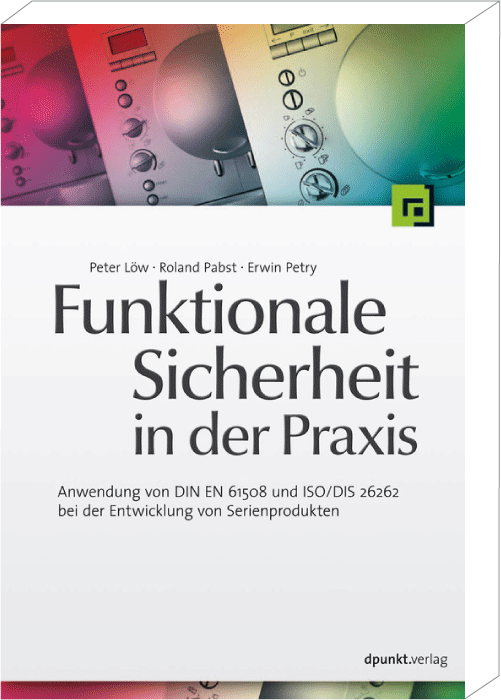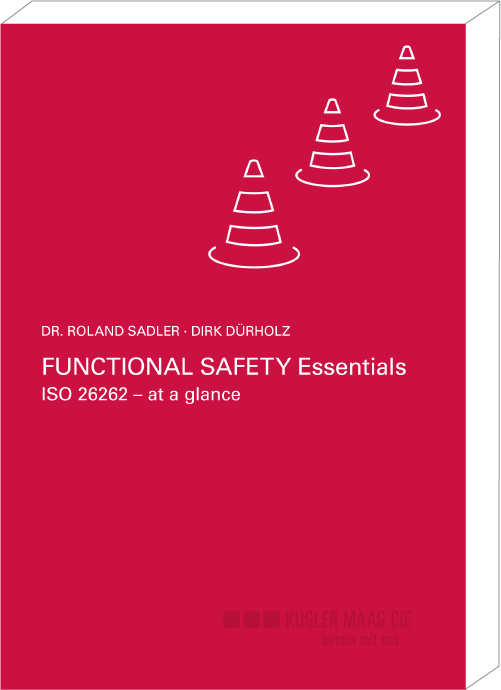
FUNCTIONAL SAFETY (ISO 26262)
Functional safety is about ensuring that nobody is exposed to a serious threat due to a malfunction in the vehicle or any of the systems contained in a vehicle. To ensure your E/E development matches the latest engineering standards, we help you develop and update your development processes, conduct safety audits and assessments, and provide experts with training.
FUNCTIONAL SAFETY – WHAT EXACTLY IS IT?
Are you involved in the development of vehicle electronics, control units, electronic systems, or components used for safety-critical functions in cars? If you are, your work is subject to the requirements of ISO 26262, a standard specifically developed for the functional safety of series-production vehicles. Developing software, embedded electronic systems and other forms of technology is becoming increasingly complex, making it necessary to meet the requirements of ISO 26262 not only to prevent damage to vehicles, but also to avoid the risk of product recalls or compensation claims.
ISO 26262 now defines required technology standards by providing an established procedural model for the development and series-production of vehicles. It also provides a standard combining the procedural model with required tasks, outputs, work products and methods that should be applied in each of these areas.
One example would be a protection device that prevents electric car windows from jamming: people have an unfortunate habit of sticking their hands out of open car windows, so this is a safety issue. A simple solution is to install a device that prevents windows closing and trapping their hands.
FUNCTIONAL SAFETY BEYOND THE LIFE CYCLE
Functional safety standards mean that every aspect of your control units, electronic vehicle components or electrical systems have to be taken into account. This means that they only adhere to ISO 26262 if they address all factors at every stage of the product life cycle – from the initial concept to development, production, and the point when a safety-critical system is taken out of operation. As experts in the development of electronic systems and machinery, we keep an open mind regarding long-term trends when introducing workflows or processes. We know the key principles, technologies and measures you will require to support you in keeping with your business goals – now and in the long term.

Need support with a key project? We’re your first port of call when it comes to management consulting and improvement programmes in electronics development.
Steffen Herrmann and the sales team
CLASSIFICATION BASED ON SAFETY INTEGRITY LEVELS
Focus on getting the task done. By using schemes like Automotive Safety Integrity Level (ASIL) defined by ISO 26262, we help you define the exact targets you will require to implement functional safety standards. This also involves maintaining a clear focus on safety-critical factors. ASIL is a useful instrument when it comes to risk assessment. As a classification scheme, it helps you ensure that systems conform with safety standards laid down under ISO 26262. There are four ASIL categories: ASIL A, ASIL B, ASIL C and ASIL D. ASIL D is the highest safety requirement, so it necessitates correspondingly high safety mechanisms.
By introducing sophisticated processes clearly structured to match the requirements of Automotive SPICE®, we ensure that your processes flow reliably and efficiently in order to deliver the required outcomes.
As experts in functional safety, we can advise you on all aspects of the ISO 26262 automotive standard, so you can rest assured that everything is shipshape.
As neutral and independent consultants, we can look at the situation in your company objectively and assess everything from the outside in. Not only do we ensure that your vehicle electronics and software-related systems adhere fully to the requirements of functional safety guidelines, we also offer our consultancy for all phases of the safety life cycle. Drawing on our know-how, we work with you to plan and design operations and projects. We've profen our competence and impartiality when it comes to functional safety assessments: Accreddited by DAkkS, Kugler Maag Cie is an official C-typeinspection body for FSA in the Automotive sector.
Your business then fulfils all requirements relating not just to functional safety standards, but also AUTOMOTIVE SPICE® –considered the de facto standard. By dovetailing functional safety with process maturity, you enhance the quality of your electronic systems and raise the efficiency of your processes. As well as integrating Automotive SPICE®-compatible workflows and AGILE PRINCIPLES into ISO 26262, we also ensure that they work in harmony side by side, without extra outlays or effort. As a result, you derive the maximum benefit on all fronts.
THE ISO 26262:2018 SAFETY STANDARD
The most recent version of ISO 26262 went live in December 2018. This second edition of the standard includes two new sections: part 11 and part 12. Parts 3 to 7 outline systems development by drawing on an interwoven V-Model (the state-of-the-art project management methodology), spanning the product life cycle from initial concept to production and decommissioning. Part 3 provides the tools required to manage functional safety. Part 8 covers supporting processes.
Parts of ISO 26262:2018
The first part of ISO 26262 outlines terms and abbreviations used by the standard.
The second part defines management tasks required during different phases of a system’s safety life cycle.
It also outlines the organisational prerequisites that need to be fulfilled to develop a system in accordance with a required ASIL – an automotive safety integrity level relating to each level of a security requirement. ISO 26262 contains certain recommendations regarding different protective measures, depending on the level a system comes under.
The third part describes the concept phase, outlining the requirements, hazard analysis and risk assessments that have to be carried out.
The hazard analysis involves identifying potential threats to a system. To do this, malfunctions are examined. Each hazard is categorised according to ASIL level A to D, or classified as not safety-critical. The higher the ASIL level, the increasingly tight safety requirements become.
The fourth part deals with development processes on a system level in keeping with the V-Model. Methods and work products are outlined for each individual process.
Methods used to meet a requirement are classified according to each ASIL – as optional, recommended or strongly recommended. If a method that is not named can be shown to be effective, it may also be used.
The fifth part deals with development processes on a hardware level in keeping with the lower segment of the V-Model. It also outlines methods and work products for each individual process.
Methods used to meet a requirement are classified according to each ASIL – as optional, recommended or strongly recommended.
The sixth part deals exclusively with development processes on a software level in keeping with the lower segment of the V-Model. It also outlines methods and work products for each individual process.
The ASIL classification model applies in the same way as the other layers.
The seventh part deals with the process of production and installation planning. The aim is to meet the requirements of functional safety during the production and installation process.
The aim of the eighth part is to define and delegate responsibilities. The requirements of the safety life cycle are specified and configuration and change management are explained. This also involves defining how tools are used.
The ninth part deals with requirements decomposition with respect to ASIL and criticality analysis. Further part look at different analysis methods used to gain a better understanding of safety-critical failures and system breakdowns.
The tenth part provides examples of applications and supplementary details on ISO 26262.
This part is more for information purposes.
The eleventh part explains the impact ISO 26262 can have on the activities of semiconductor producers.
The last part deals with motorcycle development.
Literature
FUNCTIONAL SAFETY IN PRACTICE
This specialist manual by Peter Löw, Roland Pabst and Erwin Petry provides a thorough overview of the functional safety standards covered by DIN EN 61508, ISO 26262 (automotive) and DIN EN 50128 (railways).
APPLICATION OF ISO 26262 TO THE DEVELOPMENT OF SERIAL PRODUCTS
This book provides a thorough overview of the standards of functional safety. As well as explaining the requirements of the basic DIN EN 61508 standard, it also looks at the ISO 26262 automotive standard and DIN EN 50128 railway standard. Interdependencies are highlighted between the different standards and maturity models like CMMI® and Automotive SPICE®, and issues that arise in actual use are also examined.
To illustrate how they are used, examples are given of solutions at all stages of product development. Specific examples are provided of product architecture, analysing and evaluating safety, required processes and methods, and tool support.
TRANSLATING THE SUBJECT MATTER OF FUNCTIONAL SAFETY INTO PRACTICE
An overview of functional safety
General requirements of the DIN EN 61508 standard
Requirements of the DIN EN 61508 standard relating to electronic systems
- Requirements of the DIN EN 61508 standard relating to software
- Standards for serial products: differences to the basic standard
- Implementation in an Automotive SPICE® or CMMI® setting
- Tools, materials and forms
The book finishes with a glossary and detailed list of references.
See the extract to read the table of contents of the specialist manual on functional safety in practice, as well as extracts from two chapters.
- 365 pages
- May 2010
- dpunkt publishing, Heidelberg
Functional Safety in Practice is only available in digital form. The e-book is available directly from dpunkt publishing.

FUNCTIONAL SAFETY ESSENTIALS
This book does what it says on the label: as well as offering a thorough introduction to the topic of functional safety, it also provides vivid descriptions of know-how derived from actual practice in industry.
YOUR INTRODUCTION TO FUNCTIONAL SAFETY
This concise book from the Essential series provides you with a ready-made overview of the requirements laid down under ISO 26262. Whether you work for an automotive company or a supplier, Safety Essentials gives answers to the basic questions.
THIS CONSOLIDATED MANUAL DESCRIBES ISO 26262 IN STRAIGHTFORWARD AND SIMPLE TERMS
- General overview of the standard
- Descriptions and interpretations of the individual elements of the standard
- An introduction to the output provided by the standard, shown as a quick overview
- Illustrations of the requirements laid down by the standard using a detailed example
- The relationships between functional safety in the automotive sector (ISO 26262), Automotive SPICE® and AGILE METHODS such as Scrum and Kanban
- Responsibility matrix: the most important areas of output under the standard shown by the typical roles fulfilled in a development organisation

WE CAN SUPPORT YOU WITH…
- Improving your processes to keep them up to date with the latest safety standards – also so you can develop and sell reliable, available, maintainable and functional products
- Designing and rolling out safety management systems
- Conducting safety audits to confirm that your safety management system fulfils relevant requirements
- in inspecting your development projects with DAkkS-accredited functional safety assessments (FSA).
- Building the capability to assess the functional safety of electronic systems and components
- Building the capability to provide staff training on all aspects of functional safety